AUDI TT COUPE 2009 Owners Manual
Manufacturer: AUDI, Model Year: 2009, Model line: TT COUPE, Model: AUDI TT COUPE 2009Pages: 316, PDF Size: 71.16 MB
Page 121 of 316

Driving Safely 111111 ______________________________________________________ __,::::;..._ _______ _
Proper adjustment of head restraints
Correctly adjusted head restraints are an important part
of your vehicle's occupant restraint system and can help to reduce the risk of injuries in accident situations.
Fig. 98 Correctly
adjusted head restraint
viewed from the side
The head restraints must be correctly adjusted to achieve
the best protection.
- Adjust the head restraint so that the upper edge of the
restraint is level with the top of your head, but no lower
than eye level and so it is as close to the back of your
head as possible ~ fig. 98.
Adjusting head restraints=> page 74.
& WARNING
Driving without head restraints or with improperly adjusted head
restraints increases the risk of serious injuries in a collision. To
help reduce the risk of injury :
• Always drive with the head restraints in place and properly
adjusted.
• Every person in the vehicle must have a properly adjusted head
restraint.
Controls and equip ment Safety first Vehicle operation
& WARNING (continued)
•
Always make sure each person in the vehicle properly adjusts
their head restraint. Each head restraint must be adjusted
according to occupants' size so that the upper edge is as even
with the top of the person's head, but no lower than eye level and
so it is as close to the back of to the head as possible .
• Never attempt to adjust head restraint while driving. If you
have driven off and must adjust the driver headrest for any reason,
first stop the vehicle safely before attempting to adjust the head
restraint.
• Children must always be properly restrained in a child restraint
that is appropriate for their age and size=>
page 157. •
Examples of improper seating positions
The occupant restraint system can only reduce the risk of
injury if vehicle occupants ore properly seated.
Improper seating positions can cause serious injury or
death . Safety belts can only work when they are properly
positioned on the body. Improper seating positions reduce
the effectiveness of safety belts and will even increase the
risk of injury and death by moving the safety belt to critical
areas of the body. Improper seating positions also increase
the risk of serious injury and death when an airbag deploys
and strikes an occupant who is not in the proper seating
position. A driver is responsible for the safety of all vehicle
occupants and especially for children. Therefore:
- Never allow anyone to assume an incorrect seating posi
tion when the vehicle is being used~& .
The following bullets list only some sample positions that will
increase the risk of serious injury and death. Our hope is that these .,_
Vehicle care Do-it-yourself service Technical data
Page 122 of 316
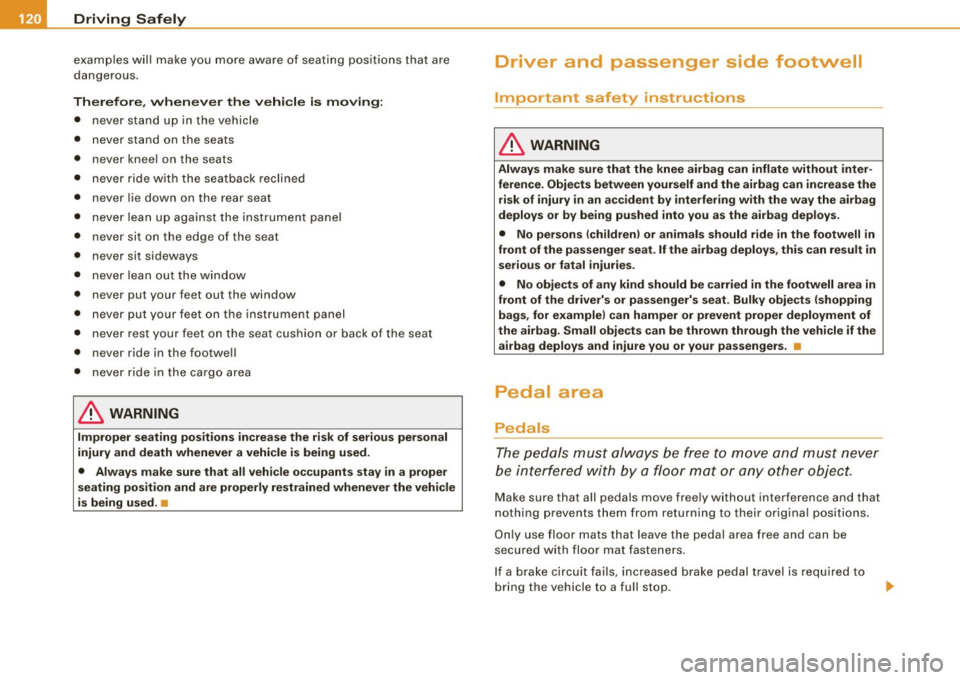
........ _o_ r_iv _i_ n""' g::;._ S_ a_f _e _ly =---------------------------------------------------
examp les w ill make you mo re aware of seating positions that ar e
d an gerous .
Therefore, whenever the vehicle is moving:
• ne ver stan d up i n the vehicle
• never stand on the seats
• never knee l on th e seats
• n ever ride with th e seatba ck re cl in ed
• never lie down on the rear seat
• nev er lea n up aga inst t he instrument pa ne l
• n ever sit on the e dge of the seat
• never sit sideways
• ne ve r le an ou t th e w indo w
• never put your feet out the window
• never put your feet on t he instrument p ane l
• n ever re st yo ur f ee t on t he seat cus hion or back of the sea t
• never ride in the footwell
• n ever ride i n the car go area
& WARNING
Improper seating positions increase the risk of serious personal
injury and death whenever a vehicle is being used.
• Always make sure that all vehi cle occupants stay in a proper
seating position and are properly restrained whenever the vehicle
is being used . •
Driver and passenger side footwell
Important safety instructions
& WARNING
Always make sure that the knee airbag can inflate without inter
ference . Objects between yourself and the airbag can increase the
risk of injury in an a ccident by interfering with the way the airbag
deploys or by being pushed into you as the airbag deploys .
• No persons (children) or animals should ride in the footwell
in
front of the passenger seat . If the airbag deploys , this can result in
serious or fatal injuries .
• No objects of any kind should be carried in the footwell area in
front of the driver's or passenger 's seat . Bulky objects (shopping
bags , for example) can hamper or prevent proper deployment of
the airbag. Small objects can be thrown through the vehicle if the
airbag deploys and injure you or your passengers. •
Pedal area
Pedals
The pedal s must a lways be fre e to move a nd mus t never
b e in terfe red with by a flo or mat or a ny othe r objec t.
Make sure that all pedals move freely w ithout interfe rence and that
n oth ing preve nts t hem fr om retu rni ng to t heir or igin a l pos itions.
On ly use floor mats that leave the pedal a rea free and can be
se cured w ith flo or mat fa stene rs.
If a bra ke circu it fai ls, i ncr eased brake pedal travel is r equ ired to
bring the veh icle to a full stop.
Page 123 of 316
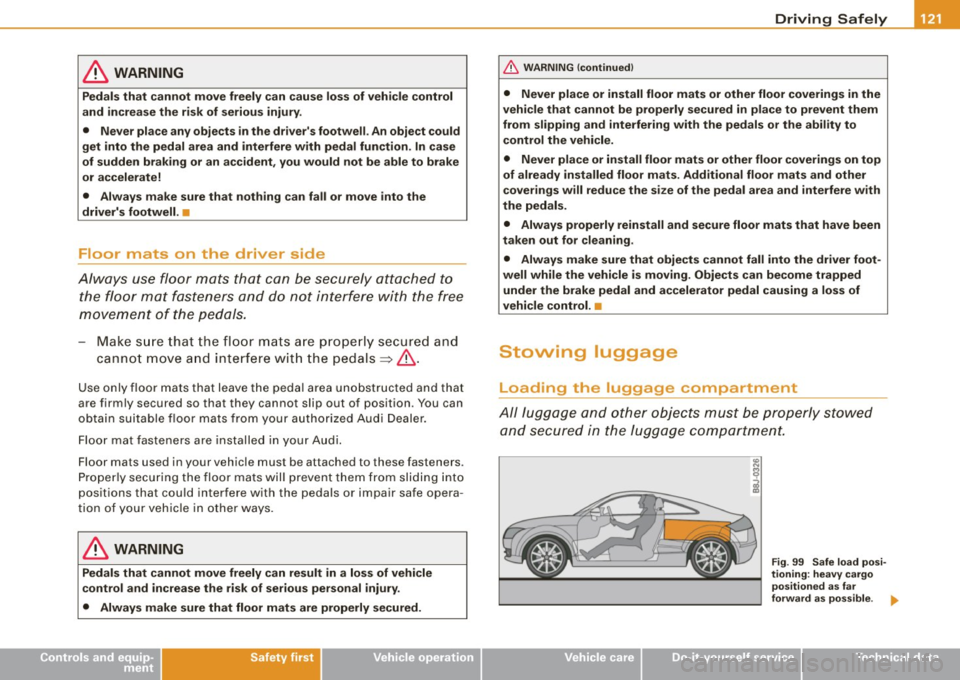
---------------------------------------------------=D..:.r..:..iv .:....:..: in..:. 9 ::!-- S .=..::a:..:f...:e :..: l~y ---
& WARNING
Pedals that cannot move freely can cause loss of vehicle control
and increase the risk of serious injury.
• Never place any objects in the driver's footwell . An object could
get into the pedal area and interfere with pedal function. In case
of sudden braking or an accident, you would not be able to brake
or accelerate!
• Always make sure that nothing can fall or move into the
driver's footwell. •
Floor mats on the driver side
Always use floor mats that can be securely attached to
the floor mat fasteners and do not interfere with the free
movement of the pedals.
- Make sure that the floor mats are properly secured and
cannot move and interfere with the pedals =>& .
Use only floor mats that leave the pedal area unobstructed and that
are firmly secured so that they cannot slip out of position . You can
obtain suitable floor mats from your authorized Audi Dealer.
Floor mat fasteners are installed in your Audi.
Floor mats used in your vehicle must be attached to these fasteners .
Properly securing the floor mats will prevent them from sliding into
positions that could interfere with the pedals or impair safe opera
tion of your vehicle in other ways.
& WARNING
Pedals that cannot move freely can result in a loss of vehicle
control and increase the risk of serious personal injury.
• Always make sure that floor mats are properly secured.
Controls and equip ment Safety first
Vehicle operation
& WARNING (continued)
• Never place or install floor mats or other floor coverings in the
vehicle that cannot be properly secured in place to prevent them
from slipping and interfering with the pedals or the ability to
control the vehicle.
• Never place or install floor mats or other floor coverings on top
of already installed floor mats. Additional floor mats and other
coverings will reduce the size of the pedal area and interfere with
the pedals.
• Always properly reinstall and secure floor mats that have been
taken out for cleaning.
• Always make sure that objects cannot fall into the driver foot
well while the vehicle is moving. Objects can become trapped
under the brake pedal and accelerator pedal causing a loss of
vehicle control. •
Stowing luggage
Loading the luggage compartment
All luggage and other objects must be properly stowed
and secured in the luggage compartment.
Vehicle care
co N
9
g!
Fig. 99 Safe load posi
tioning: heavy cargo
positioned as far
forward as possible. ..
Do-it-yourself service Technical data
Page 124 of 316
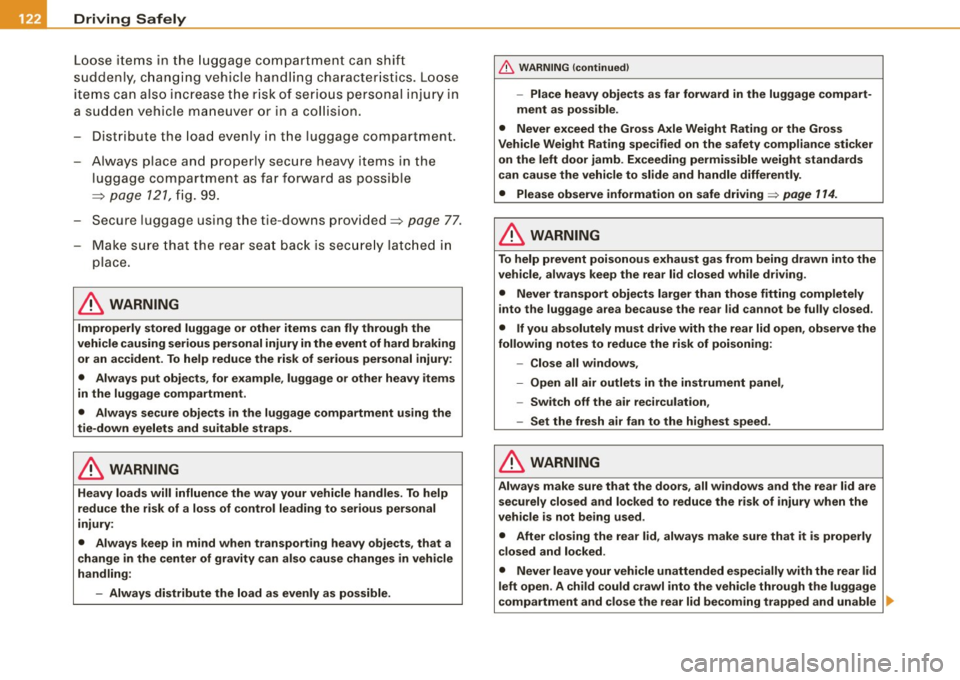
-Driving Safely at'f:I..,____--=-------=----------------
Loose items in the luggage compartment can shift
suddenly, changing vehicle handling characteristics. Loose
items can also increase the risk of serious personal injury in
a sudden vehicle maneuver or in a collision.
- Distribute the load evenly in the luggage compartment.
- Always place and properly secure heavy items in the
luggage compartment as far forward as possible
~ page 121, fig. 99.
Secure luggage using the tie-downs provided~
page 77.
- Make sure that the rear seat back is securely latched in
place.
& WARNING
Improperly stored luggage or other items can fly through the
vehicle causing serious personal injury in the event of hard braking or an accident. To help reduce the risk of serious personal injury:
• Always put objects , for example, luggage or other heavy items
in the luggage compartment.
• Always secure objects in the luggage compartment using the
tie-down eyelets and suitable straps.
& WARNING
Heavy loads will influence the way your vehicle handles. To help
reduce the risk of a loss of control leading to serious personal
injury:
• Always keep in mind when transporting heavy objects, that a
change in the center of gravity can also cause changes in vehicle
handling:
-Always distribute the load as evenly as possible.
& WARNING (continued)
-Place heavy objects as far forward in the luggage compart
ment as possible.
• Never exceed the Gross Axle Weight Rating or the Gross
Vehicle Weight Rating specified on the safety compliance sticker
on the left door jamb. Exceeding permissible weight standards
can cause the vehicle to slide and handle differently.
• Please observe information on safe driving~
page 114.
& WARNING
To help prevent poisonous exhaust gas from being drawn into the
vehicle, always keep the rear lid closed while driving.
• Never transport objects larger than those fitting completely
into the luggage area because the rear lid cannot be fully closed.
• If you absolutely must drive with the rear lid open, observe the
following notes to reduce the risk of poisoning:
-Close all windows,
- Open all air outlets in the instrument panel,
- Switch off the air recirculation,
- Set the fresh air fan to the highest speed.
& WARNING
Always make sure that the doors, all windows and the rear lid are
securely closed and locked to reduce the risk of injury when the
vehicle is not being used.
• After closing the rear lid, always make sure that it is properly
closed and locked .
• Never leave your vehicle unattended especially with the rear lid
left open. A child could crawl into the vehicle through the luggage
compartment and close the rear lid becoming trapped and unable
~
Page 125 of 316

Driving Safely -
----------------
& WARNIN G (continu ed )
to get out . Being tr apped in a vehi cle can lead to serious personal
injury.
• Never let children play in or around the vehicle .
• Never let pa ssengers ride in the lugg age compartment . Vehicle
occupants must always be properly restrained in one of the
vehicle 's seating po sitions.
[ i ] Tips
• Air circu lation helps to reduce window fogging. Stale air escapes
to the outside through vents in the trim pane l, on the left side of the
luggage compa rtme nt. Be sure t o keep t hese s lo ts free a nd ope n.
• T he tire pressure must correspond to the load -see the tire pres
sure sticker on driver's side B-pillar. •
Tie-downs
The lu ggag e com part men t is eq uipp ed wit h four tie
d o wns to se cu re l uggag e and other it e ms .
Use the tie -downs to secure your car go properly=> page 121,
"Lo ad in g the luggage com partme nt".
I n a col lision, the laws o f physics mea n tha t even smaller items tha t
are loose in the vehic le will become heavy missiles that can cause
se rious i nju ry . It em s i n t he vehicl e possess e nergy w hich vary with
vehic le speed and the weight of the item. Vehic le speed is the most
s igni ficant factor .
For example, in a frontal co llision at a speed of 30 mph (48 km/h),
the forces acting on a 10 -lb ( 4.5 kg) object are about 20 times the
normal weight of the item. This means that the weight of t he item
would suddenly be about 2 00 lbs. (90 kg). You can imagine the inju
ries that a 200 lbs. (90 kg) item fl ying free ly t hrou gh th e passe nge r
compartment could cause in a co llision like this .
Controls and equip
ment Safety first Vehicle operation
& WARNING
Weak
, damaged or imp roper straps used to secure items to tie
downs can fail during hard braking or in a collision and cause
serious personal injury .
• Always use suitable mounting straps and properly secure
items to the tie -downs in the luggage compartment to help
prevent items from shifting or flying forward as dangerous
missiles .
• When the rear seat backrest is folded down , always use suit
able mounting straps and properly secure items to the tie -downs
in the luggage compartment to help prevent items from flying
forward as dangerous missiles into the passenger compartment .
• Never attach a child safety seat tether strap to a tie -down. •
Reporting Safety Defects
Applicable to U.S.A. If you believe that your vehicle has a defect
which could cause a crash or could cause injury or death , you should immediately inform
the National Highway Traffic Safety Adminis
tration (NHTSA) in addition to notifying Audi of
America , Inc.
If NHTSA receives similar complaints , it may
open an investigation, and if it finds that a
safety defects exists in a group of vehicles , it
may order a recall and remedy campaign.
However, NHTSA cannot become involved in ..,
Vehicle care Do-it-yourself service Technical data
Page 126 of 316
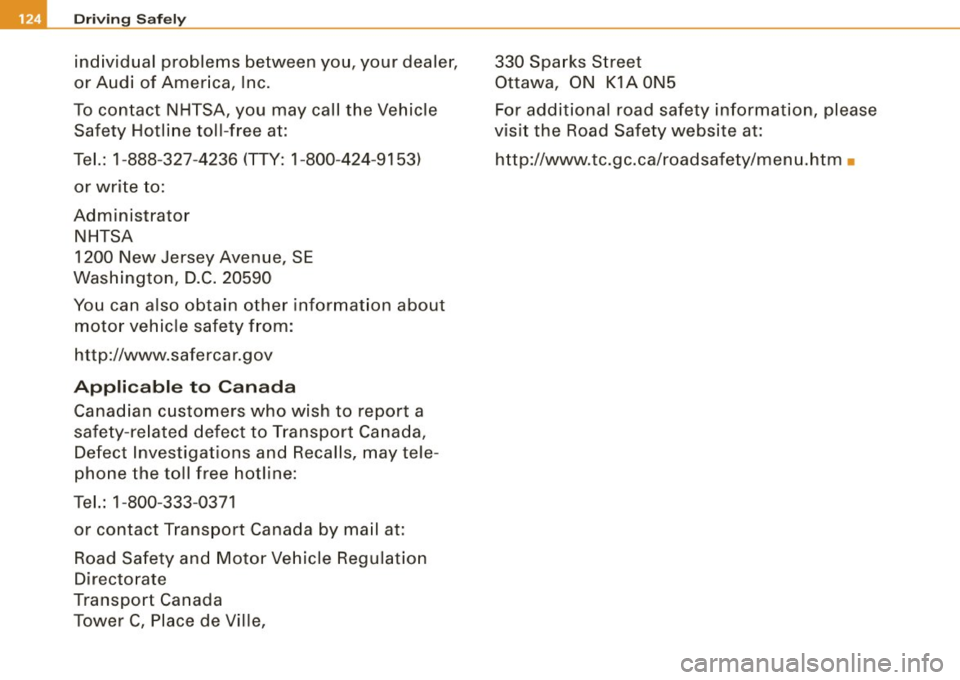
lllffl Driving Safely
individual problems between you, your dealer,
or Audi of America, Inc.
To contact NHTSA, you may call the Vehicle
Safety Hotline toll -free at:
Tel.: 1-888-327-4236 (TIY: 1-800-424-9153)
or write to:
Administrator NHTSA
1200 New Jersey Avenue, SE
Washington, D.C. 20590
You can also obtain other information about
motor vehicle safety from:
http://www.safercar.gov
Applicable to Canada
Canadian customers who wish to report a
safety-related defect to Transport Canada, Defect Investigations and Recalls, may tele
phone the toll free hotline:
Tel.: 1-800-333-0371
or contact Transport Canada by mail at:
Road Safety and Motor Vehicle Regulation
Di recto rate
Transport Canada
Tower C, Place de Ville, 330 Sparks Street
Ottawa, ON K1A 0N5
For additional road safety information, please
visit the Road Safety website at:
http://www. tc.gc.ca/roadsafety/menu .htm •
Page 127 of 316

Safety belts -----------------=------
Safety belts
General notes
Always wear safety belts!
Wearing safety belts correctly saves lives!
This chapter explains why safety belts are necessary, how they work and how to adjust and wear them correctly.
- Read all the information that follows and heed all of the
instructions and WARNINGS.
& WARNING
Not wearing safety belts or wearing them improperly increases
the risk of serious personal injury and death.
• Safety belts are the single most effective means available to
reduce the risk of serious injury and death in automobile acci
dents. For your protection and that of your passengers, always
correctly wear safety belts when the vehicle is moving.
• Pregnant women, injured, or physically impaired persons must
also use safety belts . Like all vehicle occupants, they are more
likely to be seriously injured if they do not wear safety belts. The
best way to protect a fetus is to protect the mother -throughout
the entire pregnancy. •
Number of seats
Your Audi TI Coupe has two seating positions in the front and two
height-limited seating positions in the rear. Each seating position
has a safety belt. The rear seat area in your Audi TT Coupe does not
have enough room for passengers of all sizes. For reasons of safety,
Controls and equip ment Safety first
Vehicle operation
no person taller than 4'11" (1.5 meters) should ever ride in the rear
seat area.
& WARNING
Not wearing safety belts or wearing them improperly increases
the risk of serious personal injury and death.
• Never strap more than one person, including small children,
into any belt. It is especially dangerous to place a safety belt over
a child sitting on your lap.
• Never let more people ride in the vehicle than there are safety
belts available.
• Be sure everyone riding in the vehicle is properly restrained
with a separate safety belt or child restraint.
• Persons taller than 4'11" (1.5 m) as well as children in booster
seats who are too close to the rear window and roof can suffer
severe head and neck injuries when the rear lid is closed or in a
crash.
• The minimum clearance between the passenger's heads and
the rear window must never - under any circumstances -be less
that 1 inch (2.5 cm.I when the passengers sit fully upright.
• Always make sure that rear seat passengers cannot be struck
when the rear lid is closed. •
Vehicle care Do-it-yourself service Technical data
Page 128 of 316
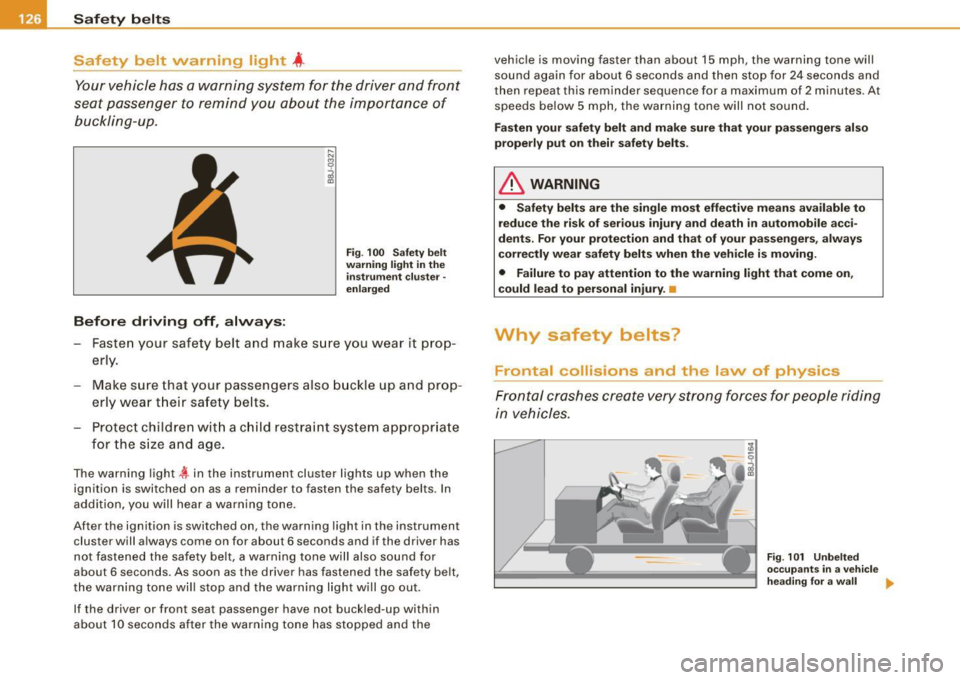
___ S_a_ f_ e_ t-= y_ b_e_ l_ t _s _______________________________________________ _
Safety belt warning light 4
Your vehicle has a warn ing system for the driver and front
seat passenger to remind you about the importance of buckling-up.
Before driving off , alw ays:
Fig . 100 Saf ety belt
w arn ing li ght in t he
in strum ent cluster -
e n la rge d
- Fasten your safety belt and make sure you wear it prop
erly.
Make sure that your passengers also buckle up and prop
erly wea r th eir safety be lts.
- Protect children wit h a c hild restraint sys tem appropria te
for the s ize and age.
The warning light tin the instrument cluster lights up when the
ignition is swi tched on as a reminder to fasten the safety belts. In
addition, you will hear a warning tone .
After the ignition is switched on , the warning light in the ins trumen t
cluster will a lways come on for about 6 seconds and if the driver has
not fastened the safety belt, a warning tone will also sound for
about 6 seconds. As soon as the driver has fastened the safety b elt,
the warning tone wil l stop and the warning light will go out.
If the driver or front seat passenger have not buckled-up within
about 10 seconds after the warning tone has stopped and the vehi
cle is moving faster than about 15 mph , the warning tone will
sound again for about 6 seconds and then stop for 24 seconds and
then repea t this reminder sequence for a maximum of 2 minu tes . At
speeds below 5 mph, the warning ton e will not sound .
Fas ten your safety belt and m ake sur e that your p as senger s al so
properly p ut o n the ir safety belt s.
& WARNING
• Saf ety belt s a re the single mo st effe ctive m ean s available to
r e d uc e the ri sk of ser iou s inj ury a nd death i n aut omobi le a cci
den ts. For your protection and that of your p assengers, always
corre ctly we ar sa fe ty belt s when the veh icle i s m oving.
• Failure to pay att ent ion t o th e w arning light that come on,
c ould l ead t o per sona l in jur y. •
Why safety be lts?
Frontal collisions and the law of physics
Frontal crashes create very strong forces for people riding
in vehicles.
--
Fig. 101 Unbe lt ed
o cc up ant s in a vehi cle
h ead ing fo r a w all
~
Page 129 of 316
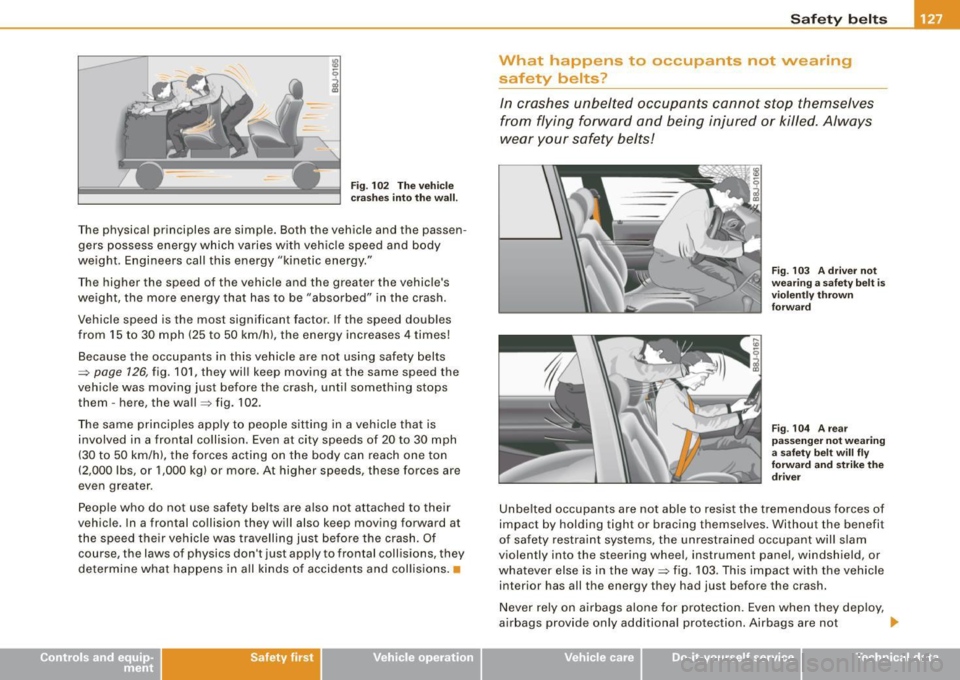
Fig. 102 The vehicle
crashes into the wall.
The physical principles are simple. Both the vehicle and the passen
gers possess energy which varies with vehicle speed and body
weight . Engineers call this energy "kinetic energy."
The higher the speed of the vehicle and the greater the vehicle's
weight, the more energy that has to be "absorbed" in the crash.
Vehicle speed is the most significant factor. If the speed doubles
from 15 to 30 mph (25 to 50 km/h), the energy increases 4 times!
Because the occupants in this vehicle are not using safety belts
~ page 126, fig . 101, they will ke ep moving at the same sp eed the
vehicle was moving just before the crash, until something stops them -here, the wall~ fig. 102 .
The same principles apply to people sitting in a vehicle that is
involved in a frontal collision . Even at city speeds of 20 to 30 mph
(30 to 50 km/h), the forces acting on the body can reach one ton
(2,000 lbs, or 1,000 kg) or more . At higher speeds , these forces are
even greater.
People who do not use safety belts are also not attached to their
vehicle. In a frontal collision they will also keep moving forward at
the speed their vehicle was travelling just before the crash. Of
course, the laws of physics don't just apply to frontal collisions, they
determine what happens in all kinds of accidents and collisions. •
Safety first
Safety belts
What happens to occupants not wearing
safety belts?
In crashes unbelted occupants cannot stop themselves
from flying forward and being injured or killed. Always
wear your safety belts!
Fig. 103 A driver not
wearing a safety belt is
violently thrown
forward
Fig . 104 A rear
passenger not wearing
a safety belt will fly
forward and strike the
driver
Unbelted occupants are not able to resist the tremendous forces of
impact by holding tight or bracing themselves. Without the benefit
of safety restraint systems, the unrestrained occupant will slam
violently into the steering wheel , instrument panel , windshield , or
whatever else is in the way~ fig. 103 . This impact with the vehicle
interior has all th e energy they had just before the crash.
Never rely on airbags alone for protection. Even when they deploy,
airbags provide only additional protection. Airbags are not
91>
Vehicle care I I irechnical data
Page 130 of 316
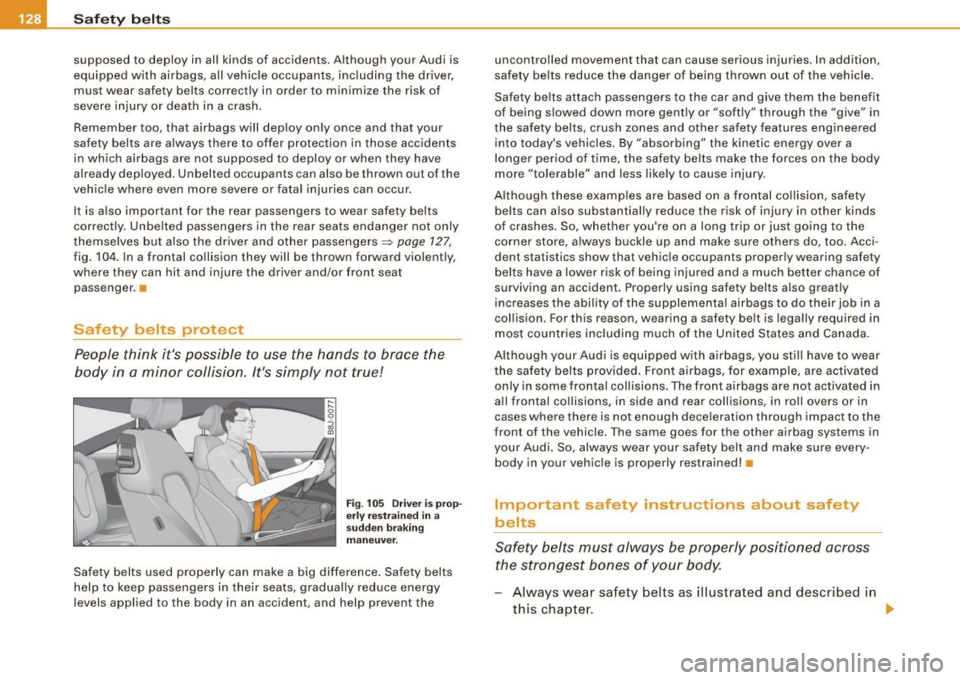
___ S_a_ f_ e_ t-= y_ b_e_ l_ t _s _______________________________________________ _
supposed to deploy in all kinds of accidents. Although your Audi is
equipped with airbags, all vehicle occupants, including the driver, must wear safety belts correctly in order to minimize the risk of
severe injury or death in a crash.
Remember too, that airbags will deploy only once and that your
safety belts are always there to offer protection in those accidents
in which airbags are not supposed to deploy or when they have
already deployed. Unbelted occupants can also be thrown out of the
vehicle where even more severe or fatal injuries can occur.
It is also important for the rear passengers to wear safety belts
correctly. Unbelted passengers in the rear seats endanger not only
themselves but also the driver and other passengers:::::,
page 127,
fig. 104. In a frontal collision they will be thrown forward violently,
where they can hit and injure the driver and/or front seat passenger. •
Safety belts protect
People think it's possible to use the hands to brace the
body in a minor collision. It's simply not true!
Fig . 105 Driver is prop
er ly restrained in a
sudden braking
maneuver.
Safety belts used properly can make a big difference . Safety belts
help to keep passengers in their seats, gradually reduce energy
levels applied to the body in an accident, and help prevent the uncontrolled movement that
can cause serious injuries. In addition,
safety belts reduce the danger of being thrown out of the vehicle.
Safety belts attach passengers to the car and give them the benefit
of being slowed down more gently or "softly" through the "give" in
the safety belts, crush zones and other safety features engineered
into today's vehicles. By "absorbing" the kinetic energy over a
longer period of time, the safety belts make the forces on the body
more "tolerable" and less likely to cause injury.
Although these examples are based on a frontal collision, safety belts can also substantially reduce the risk of injury in other kinds
of crashes. So, whether you're on a long trip or just going to the
corner store, always buckle up and make sure others do, too . Acci
dent statistics show that vehicle occupants properly wearing safety
belts have a lower risk of being injured and a much better chance of
surviving an accident. Properly using safety belts also greatly
increases the ability of the supplemental airbags to do their job in a
collision . For this reason, wearing a safety belt is legally required in
most countries including much of the United States and Canada.
Although your Audi is equipped with airbags, you still have to wear
the safety belts provided. Front airbags, for example, are activated
only in some frontal collisions. The front airbags are not activated in
all frontal collisions, in side and rear collisions, in roll overs or in
cases where there is not enough deceleration through impact to the
front of the vehicle. The same goes for the other airbag systems in
your Audi. So, always wear your safety belt and make sure every body in your vehicle is properly restrained! •
Important safety instruct~ons about safety
belts
Safety belts must always be properly positioned across
the strongest bones of your body.
Always wear safety belts as illustrated and described in
this chapter. _,